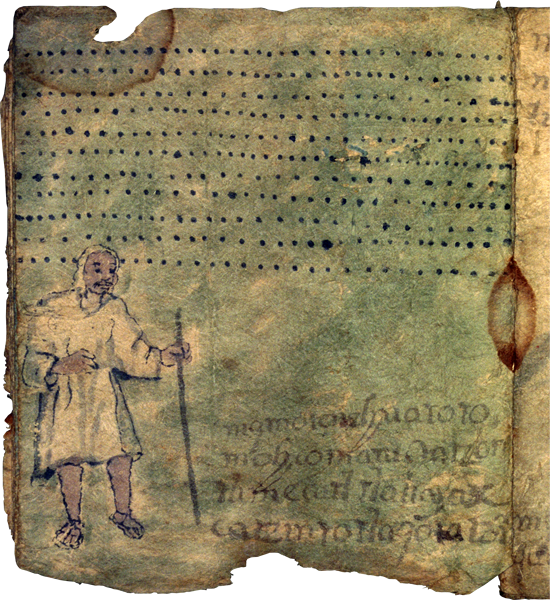f. 6v., entire face of one folio (pictorial and textual)
This page, which is the back side of the sixth folio of eighteen folios, is typical of the image-heavy pages that feature landscapes included in these territorial claims of San Cristóbal Texcalucan and Santa María Magdalena Chichicaspa in the municipality of Huixquilucan (modern State of Mexico) late in the Spanish colonial period.
On this page we see an indigenous man standing, dressed in white cotton clothing typical of the Spanish colonial period, and holding a staff in his left hand. The staff is probably a symbol of his authority in the local community. He may be an office holder on the town council. Text runs across the bottom of the page. Black dots cross the top half of the page, organized in eleven horizontal rows, close together. These may represent a seeded field, possibly planted with maize kernels. A green watercolor wash covers the whole page, suggesting perhaps that this is a grassy, rural area.
A stain appears in the binding at about the middle of the page. Another (water?) stain appears in the upper left corner, where there is also a bit of the paper torn away. The bottom central portion of the page shows erosion that was probably owing to the leaves having been bound by a cord at some point.
página entera de un folio (pintura y texto)
Esta página, que es la parte de atras del folio sexto (6 recto) de dieciocho folios, es típica de las páginas con imagen-pesada que documenta paisajes incluyendo estos reclamos territoriales de San Cristóbal Texcalucan y Santa María Magdalena Chichicaspa en el municipio de Huixquilucan (Estado de México) posteriormente en el período colonial Español.
En está página vemos un hombre indígena parado, vestido en ropa blanca de algodón típica del periodo Español colonial., y agarrando un bastón en su mano izquierda. El bastón es probablemente símbolo de autoridad en la comunidad local. El a lo mejor es una persona que mantiene una oficina en el consejo del pueblo. Texto corre cruzando la parte de abajo de la página. puntos negros cruzan la parte de arriba de la página, organizando once líneas horizontales, cercanas. Esto puede representar una campo de semillas, posiblemente plantadas con granos de maiz. Un verde pintado co acuarelas lavada cubre toda la página, sugiriendo quizas que es una area de pasto, una area rural.
Aparece una mancha en la cubierta en medio de la página. Otra (agua?) mancha aparece en la esquina izquierda de arriba, donde también hay una pequeña roptura. La porción de abajo en medio de la página muestra erosion que posiblemente debe a las plantas que estuvieron juntas por una cuerda en algún tiempo.
